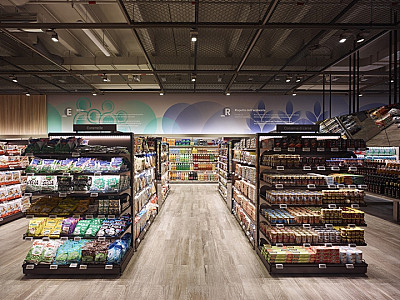Indonesia Wants its Groceries Faster Than Ever
The technological advancement and current pandemic situation had left a huge impact towards the advancement of the e-grocery industry. Here's what you should know.



The revolutionary trend of live shopping, also known as live commerce, has been reshaping Indonesia's online shopping landscape since the end of the pandemic.
Wonder why and how far this fusion of entertainment, convenience, and social interaction has captured the attention and wallets of consumers across the nation?
Through this article, let’s discover the multifaceted reasons behind the rise of live shopping and explore the key players who are driving this transformative trend forward.
Live shopping is an interactive e-commerce concept that merges the nostalgia of 90s television shopping with digital age. Through real-time video broadcasts, hosts or influencers showcase products, engage with viewers, and offer instant purchase options.
During the live show, viewers can ask questions, request product demonstrations, and make purchases seamlessly, creating an engaging shopping experience from the comfort of their screens.
Live shopping benefits brands by enabling them to illustrate their products in action, emphasizing crucial attributes and advantages that 2D images and written explanations cannot convey.
Another great benefit to live shopping is it empowers brands to instill a sense of urgency and exclusivity. By providing time-limited promotions, flash sales, or exclusive deals during the live broadcast, shoppers are more motivated to make purchases immediately, resulting in boosted sales and augmented revenue for the brands.
For customers who can get easily bored with the usual online shopping experience, live shopping becomes a more powerful method to build brand loyalty and a sense of togetherness.
Indonesia's digitally-savvy and diverse population has embraced live shopping with open arms.
The country's flourishing social media environment and status as the world's fourth-largest market for smartphones have significantly contributed to the swift adoption of this emerging trend.
By February 2022, Indonesia boasted a staggering 191.4 million active users on social media. With 20 million already engaging in online shopping by 2017, it is unsurprising that new digital trends like live shopping find rapid acceptance among the nation's people.
A Populix survey revealed Indonesian consumer preferences and engagement. In fact, live shopping's surge is predominantly driven by the fashion sector (85%), followed by beauty (54%), and lifestyle (41%).
The survey results further uncovered that Indonesians engage in online shopping at least two to four times per month, with an average budget of IDR 200,000 per transaction.
What consumers usually look for in live shopping scenes are accessing brand promotions and discounts. The most appealing offers for them include free delivery (91%), discounts (87%), cashback (65%), vouchers (47%), bundled deals (34%), and exclusive product launches (20%).
As live shopping gains traction in Indonesia, dominant players have emerged. Shopee Live leads the way with a commanding 74% market share, followed by TikTok Live (20%), Tokopedia Play (10%), and LazLive (9%).
The Co-Founder and CEO of Populix stated that this survey results aligned with their data, underscoring Shopee Live as the largest market holder with the highest transaction numbers and greatest transaction value among Indonesian ecommerce platforms.
A similar result is echoed by a Ninjavan survey, which proclaimed Shopee (27%) as the most favored live commerce platform in Southeast Asia in 2022. In contrast, Instagram and YouTube receive lesser favor, with only 7% and 3% of respondents expressing their preferences.
Surprisingly, despite Shopee and TikTok's clear domination among consumers, Tokopedia (76%) actually emerged as the most trusted platform among small and medium business owners. In regard to live shopping specifically, Medan, Bandung, Semarang, Surabaya, and Sidoarjo were the top five cities with the highest Tokopedia Play audiences in the first half of 2023.
Business owners indicate that diverse payment methods (73%), ease of use (70%), comprehensive features (68%), reliable resolution center service (66%), efficient logistics facilities (70%), and seamless user interface (70%) stand as prime reasons for their greater trust in Tokopedia compared to other platforms.
Regardless of which platform is winning, it's evident that both local and global brands have leveraged live shopping to broaden their audience reach and enhance revenue streams.
However, a question arises regarding the extent to which brands spend time and resources toward crafting live broadcasts.
During its initial emergence, the live shopping method encountered skepticism. Some believed it could potentially harm local MSMEs due to an emphasis on imported products and high technology use.
Yet, according to marketplace expert Jonathan Ko, the appearance of new selling methods like live shopping can actually build up opportunities for local MSMEs.
Compared to manually uploading photos onto ecommerce platforms and promoting them via social media, sellers can conserve capital and effort by promoting products through live shopping. This is especially beneficial for those who aren't particularly tech-savvy.
"Previously, sellers had to learn algorithms, composing product descriptions, using a laptop, and navigate other complexities. In contrast, on platforms like TikTok, new sellers can simply upload products, add titles, and go live with their phones to directly showcase their products," as outlined by Ko.
Live shopping is also evidently a lot simpler compared to social commerce, which needs a big online presence, striking graphics, and an integration to traditional ecommerce platforms or websites.
Despite exhibiting impressive expansion and potential, it's vital to acknowledge that live shopping doesn't directly overthrow traditional commerce.
Rather than replacing traditional commerce, live shopping complements it by introducing an interactive and entertainment-oriented dimension to the shopping experience.
Danny Wong, Head of Growth and Innovation at APAC TEAM LEWIS, expanded on this concept, noting that "customers view live shopping as a platform for accessing exclusive discounts and a space to discover new products."
Xen Chia, Strategic Marketing Director at XGATE, also added that live shopping addresses the social interaction gap inherent in e-commerce. Hence, it's improbable that live shopping will replace traditional e-commerce, as the two co-exist symbiotically, catering to different target audiences and serving different purposes.
Are you ready to seize the exciting opportunities of this dynamic ecommerce trend? Whether you're a brand looking to amplify your reach, a business owner seeking to navigate the new landscape, or curious enthusiasts wanting to stay ahead of the curve, Askpert.id's experts offer insights, guidance, and practical tips to harness the power of live shopping effectively.
We will give you updates of our latest news
The technological advancement and current pandemic situation had left a huge impact towards the advancement of the e-grocery industry. Here's what you should know.

GoTo is set to IPO in the Indonesian market. Here are some facts you need to know.

The Dark Store appearance is seen as the e-grocery supply evolution, here’s what you need to know.

Although the 5G network has been around for a while, the world appears to be pessimistic about how much profit it can gather. Does Indonesia have a similar opinion?
